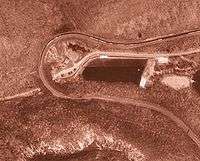Horseshoe curve

A horseshoe curve is a reversing curve through a single tight curve in a railway or a road, through an angle of about 180 degrees or more. The U shape, or even slight balloon shape, of such a curve resembles a horseshoe, hence the name. On roads such curves, if tight enough, are typically called hairpin turns.
A horseshoe curve is a means to lengthen an ascending or descending grade and thereby reduce the maximum gradient. If the straight route between two points would be too steep to climb, a more circuitous route will increase the distance travelled, allowing the difference in altitude to be averaged over a longer track (or road) length. This is similar to the function of a spiral. However, a horseshoe curve does not involve the track crossing over itself, and the full horseshoe involves both relatively straight and tightly curved sections, while a spiral generally has a more uniform curvature. Obviously, a horseshoe also gives rise to a severe change in direction, while a spiral generally does not.
A horseshoe curve is sometimes used where the route bridges a deep gully. Deviating from a straight-line route along the edge of the gully may allow it to be crossed at a better location.
Horseshoe curves are common on railway lines in steeply graded or hilly country, where means must be found to achieve acceptable grades and minimize construction costs. As with spirals, the main limitation in laying out a horseshoe is keeping its radius as large as possible, as sharp curves limit train speed.
Examples
North America
- Horseshoe Curve (Pennsylvania), Kittanning Gap, Pennsylvania; Pennsylvania Railroad.
- Five curves on the California Western Railroad climbing the coast range east of Fort Bragg, California[1]
- Ophir Loop; Ophir, Colorado; Rio Grande Southern Railroad – 3 ft (914 mm) gauge (abandoned)
- Coxo Curve; Cumbres, Colorado; Denver and Rio Grande Western Railway; 3 ft (914 mm) gauge
- Tanglefoot Curve; Cumbres, Colorado; Denver and Rio Grande Western Railway; 3 ft (914 mm) gauge
- Los Pinos Curve; Los Pinos, Colorado; Denver and Rio Grande Western Railway; 3 ft (914 mm) gauge
- Phantom Curve; Sublette, Colorado; Denver and Rio Grande Western Railway; 3 ft (914 mm) gauge
- Whiplash Curve; Big Horn, Colorado; Denver and Rio Grande Western Railway; 3 ft (914 mm) gauge
- Lava Loop; Lava, Colorado; Denver and Rio Grande Western Railway; 3 ft (914 mm) gauge
- Altura Curve; Altura, Colorado; Rio Grande, Pagosa and Northern; 3 ft (914 mm) gauge (abandoned)
- 66° curve; Moro Castle, Colorado; Uintah Railway; 3 ft (914 mm) gauge (abandoned)[2]
- Balloon Loop; Columbine, Colorado; Uintah Railway; 3 ft (914 mm) gauge (abandoned)[2]
- Hairpin Curve and Muleshoe Curve; McAndrews, Colorado; Uintah Railway; 3 ft (914 mm) gauge (abandoned)[2]
- Coles Curve; Coles, Pennsylvania; East Broad Top Railroad;– 3 ft (914 mm) gauge (out of service)
- Foss Creek, between Skykomish, Washington and the Cascade Tunnel.
- Muleshoe Curve, near Duncansville, Pennsylvania; Pennsylvania Railroad.
- Chorro, California on the grade from San Luis Obispo to Cuesta Pass, a route owned by the Union Pacific Railroad and used by Amtrak's Coast Starlight (Los Angeles, CA to Seattle, WA).
- The Cantara Loops between Dunsmuir, California and Mount Shasta, California. Map
- East of Oakridge, Oregon on the Cascade Line.
- Notch Hill, on CP's Shuswap Sub near Salmon Arm, British Columbia.
- "Mance Curve," between Meyersdale & Hyndman, PA along Sand Patch Grade (a section of track that's part of CSX Transportation's Keystone Subdivision) which is used both by freight trains and Amtrak's Capitol Limited (Chicago, IL-Washington, DC)
Asia
- Kamaishi Line of East Japan Railway Company in Japan, has a horseshoe curve from Kamiarisu Station down to Rikuchū-Ōhashi_Station ("down" on the elevation and registration of direction of the line).
- Nanning–Kunming Railway in China, inside Yiliang County, located in the east of Yiliang Town.
Australasia
- Picton railway station, New South Wales, turns back on itself at about 225 degrees.
- The Raurimu Spiral in New Zealand has a horseshoe curve as the first part of the climb.
- The U-bend south of Maddingly, Victoria takes a large detour to descend 100m.
- Turangarere, New Zealand North Island Main Trunk line near Hihitahi.
Europe

Credit: Anders Beer Wilse
- Dovrebanen, the main line of the Norwegian railway network, has a horseshoe from Dombås at the steep hills to the Dovre plateau.
- Flåmsbana, Norway, has a double horseshoe, one inside a tunnel, one in the open, few kilometres below top station.
- Raumabanen (Rauma Line), Norway, has a double horseshoe through the steep and narrow valley at Verma, one inside a tunnel and one that includes the Kylling Bridge.
- Grybów, Poland has a horseshoe curve 2,5 km west of the town.
- Kalisz, Poland has a double horseshoe curve leading the tracks from a flat plateau down to the valley of the Prosna river.
- Between Jelenia Góra and Szklarska Poręba in Poland there is a five-times, elongated horseshoe curve (50°51′19"N, 15°34′17"E). Map
- Newcastle Quayside branch, a goods-only railway from the main line to the river quayside, through a steeply descending horseshoe tunnel.
- The Rhein-Ruhr S-Bahn in Germany has a horseshoe curve in Neviges, Velbert on the route between Essen and Wuppertal, known as the Prince William railway.
- The horseshoe curve on the West Highland Line in Scotland between Upper Tyndrum and Bridge of Orchy was built because the engineers of the railway couldn't afford to build a viaduct crossing the remote valley.
- In Slovakia there is a significant number of horseshoe curves on the Banská Bystrica to Turčianske Teplice railway track and on the railway from Zvolen to Turčianske Teplice. More than 20 tunnels and couple of horseshoe curves were built to overcome rough terrain and elevation differences.
References
| ||||||||||||||||||||||||||
